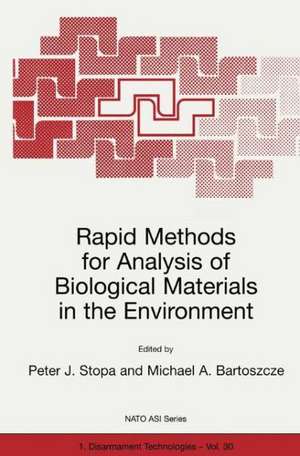Rapid Methods for Analysis of Biological Materials in the Environment: NATO Science Partnership Subseries: 1, cartea 30
Editat de Peter J. Stopa, Michael A. Bartoszczeen Limba Engleză Paperback – 22 sep 2011
The present book first discusses current and emerging military and civilian policies on the environment. In addition, the impact of environmental biology on the future of space exploration is discussed, especially in reference to the Mars mission. There follows a discussion of the state of bacteria in the environment, with a presentation of current and emerging techniques of microbial investigation. Finally, two case studies are presented on the impact of these techniques on both political and environmental problems.
Din seria NATO Science Partnership Subseries: 1
- 15%
 Preț: 643.65 lei
Preț: 643.65 lei - 18%
 Preț: 949.23 lei
Preț: 949.23 lei - 18%
 Preț: 951.14 lei
Preț: 951.14 lei - 18%
 Preț: 950.96 lei
Preț: 950.96 lei - 18%
 Preț: 1226.42 lei
Preț: 1226.42 lei -
 Preț: 392.97 lei
Preț: 392.97 lei - 18%
 Preț: 944.36 lei
Preț: 944.36 lei - 18%
 Preț: 1227.04 lei
Preț: 1227.04 lei - 18%
 Preț: 1220.26 lei
Preț: 1220.26 lei - 18%
 Preț: 947.35 lei
Preț: 947.35 lei - 18%
 Preț: 952.09 lei
Preț: 952.09 lei - 18%
 Preț: 955.56 lei
Preț: 955.56 lei - 15%
 Preț: 643.65 lei
Preț: 643.65 lei - 18%
 Preț: 947.67 lei
Preț: 947.67 lei - 18%
 Preț: 1111.97 lei
Preț: 1111.97 lei - 18%
 Preț: 1230.66 lei
Preț: 1230.66 lei - 5%
 Preț: 2125.27 lei
Preț: 2125.27 lei - 15%
 Preț: 650.86 lei
Preț: 650.86 lei - 18%
 Preț: 949.23 lei
Preț: 949.23 lei - 15%
 Preț: 640.37 lei
Preț: 640.37 lei - 15%
 Preț: 650.37 lei
Preț: 650.37 lei - 18%
 Preț: 1225.16 lei
Preț: 1225.16 lei - 18%
 Preț: 945.14 lei
Preț: 945.14 lei - 5%
 Preț: 1407.87 lei
Preț: 1407.87 lei -
 Preț: 398.15 lei
Preț: 398.15 lei -
 Preț: 390.46 lei
Preț: 390.46 lei
Preț: 391.40 lei
Nou
Puncte Express: 587
Preț estimativ în valută:
74.92€ • 81.41$ • 62.97£
74.92€ • 81.41$ • 62.97£
Carte tipărită la comandă
Livrare economică 22 aprilie-06 mai
Preluare comenzi: 021 569.72.76
Specificații
ISBN-13: 9789048154555
ISBN-10: 9048154553
Pagini: 352
Ilustrații: XVIII, 333 p. 114 illus.
Dimensiuni: 155 x 235 x 18 mm
Greutate: 0.49 kg
Ediția:Softcover reprint of the original 1st ed. 2000
Editura: SPRINGER NETHERLANDS
Colecția Springer
Seria NATO Science Partnership Subseries: 1
Locul publicării:Dordrecht, Netherlands
ISBN-10: 9048154553
Pagini: 352
Ilustrații: XVIII, 333 p. 114 illus.
Dimensiuni: 155 x 235 x 18 mm
Greutate: 0.49 kg
Ediția:Softcover reprint of the original 1st ed. 2000
Editura: SPRINGER NETHERLANDS
Colecția Springer
Seria NATO Science Partnership Subseries: 1
Locul publicării:Dordrecht, Netherlands
Public țintă
ResearchCuprins
Some Problems Concerning Biological Threats.- Technologies for Monitoring the Biological and Toxin Weapons Convention: An Emerging Consensus?.- Robotics Mission to Mars from Exobiological Point of View.- Dormancy in Non-Sporulating Bacteria: Its Significance for Environmental Monitoring.- Monitoring the Bacterial Neuston.- The Past, Present and Future of Luminometric Methods in Biological Detection.- Environmental Applications of the NRL Flow Immunosensor.- Capillary Electrophoresis/Nucleic Acid Probe Identification of Biological Warfare Agent Simulants.- Rapid Method for Bacterial Counting in the Milk by Using Biosensor Based on E. coli Cells.- Tiny-TOF Mass Spectrometer for Biodetection.- Intelligent Systems for the Characterization of Microorganisms from Hyperspectral Data.- Field Applications of Flow Cytometry.- A Portable Flow Cytometer for the Detection and Identification of Microorganisms.- Biodiversity of Bacterial Populations Monitored by Flow Cytometry.- Measurement of Biological Aerosol with a Fluorescent Aerodynamic Particle Sizer (Flaps): Correlation of Optical Data with Biological Data.- Measurement of Biological Aerosols in an Aerosol Chamber.- Development of PCR-Based Assays for the Detection and Molecular Genotyping of Microorganisms of Importance to Biological Warfare.- Use of Taqman, Light Cycler, and Confocal Microscopy to Detect Specific PCR.- Evaluation of the Polymerase Chain Reaction Assays for Identifying Biological Agents.- Identification of Pathogens Using Single/Double Strand Conformation Polymorphism (SSCP/DSCP) Analysis.- Use of PCR for Identification and Detection of Biological Agents.- Comparative Performance of Conventional and Molecular Dosimetry Methods in Environmental Biomonitoring: Assessment using Bacillus-based Commercial Biopesticides as Models.- Workshop Conclusions.- Appendixes.- First Day’s Panel Discussion on the Status of the Environment.- Discussion on Mass Spectometry.- Discussion on Classical Techniques.- Discussion on Nucleic Acid Probe Techniques (individual papers).- Panel Discussion on DNA Techniques.- Discussion on the paper of V. Seligy.- Panel Discussion: Summary of the Meeting.










